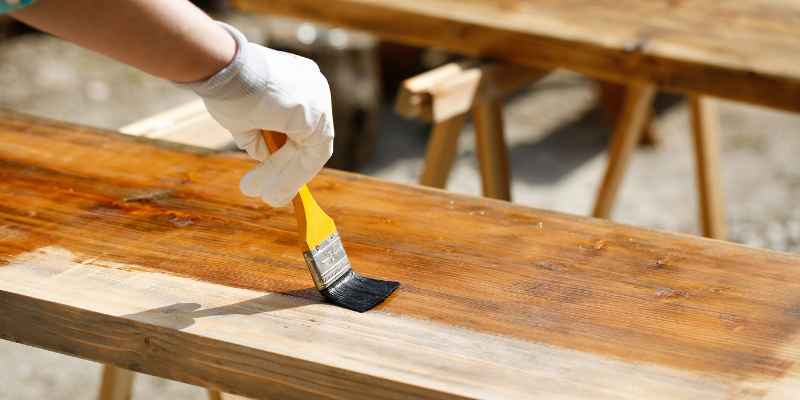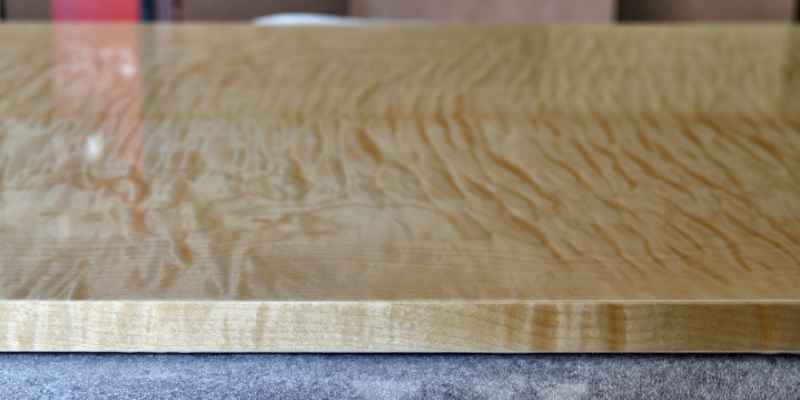To achieve a high gloss finish on wood, apply several coats of a high-quality gloss varnish, ensuring each layer is completely dry before applying the next. Additionally, sand the wood with fine-grit sandpaper between each coat to create a smooth surface.
This process will result in a stunning glossy finish that enhances the natural beauty of the wood.
Types Of Finishes For Wood
When it comes to enhancing the natural beauty of wood, choosing the right finish is crucial. There are several types of finishes available, each with its own unique characteristics and benefits. In this article, we will explore three commonly used finishes for wood: oil-based finishes, water-based finishes, and polyurethane finishes.
Oil-based Finishes
An oil-based finish is one of the most traditional options for achieving a high gloss finish on wood. It is made by combining oil, such as linseed or tung oil, with a resin or varnish. This type of finish penetrates the wood, providing a deep, rich color and a durable protective layer.
Pros:
- Enhances the natural beauty of the wood grain
- Provides a warm and lustrous finish
- Offers excellent durability and resistance to wear and tear
- Easy to apply and maintain
- Can be used on both interior and exterior wood surfaces
- Cons:
- Takes longer to dry compared to other finishes
- Can emit strong fumes during application
- Requires proper ventilation
Water-based Finishes
Water-based finishes have gained popularity in recent years due to their low VOC (volatile organic compounds) content and environmental friendliness. These finishes are made by suspending acrylic or polyurethane particles in water. They provide a clear, glossy, and durable finish that dries quickly.
Pros:
- Low odor and low VOC emissions
- Fast drying time
- Easy to clean up with soap and water
- Non-yellowing formula retains the natural color of the wood
- Provides excellent resistance to scratches and stains
- Cons:
- May not bring out the depth of the wood grain as well as oil-based finishes
- May require more coats for a high-gloss finish
- Not as heat-resistant as other finishes
Polyurethane Finishes
Polyurethane finishes are known for their durability and versatility. They are available in both oil-based and water-based formulations. These finishes contain polyurethane resins, which create a protective coating on the wood surface, providing excellent resistance to scratches, stains, and moisture.
Pros:
- Offers a high level of protection against wear and tear
- Provides a glossy, smooth finish
- Easy to clean and maintain
- Available in both oil-based and water-based options
- Can be used on various wood surfaces
- Cons:
- May require rigorous surface preparation for proper application
- Oil-based polyurethane can produce strong fumes during application
- Water-based polyurethane may require more coats to achieve a high-gloss finish

Preparing The Wood Surface
Before achieving a high gloss finish on wood, it is crucial to properly prepare the wood surface. This ensures that the finish adheres smoothly and flawlessly to the wood, resulting in a beautiful and professional-looking outcome. There are three main steps involved in preparing the wood surface: sanding the wood, filling the grain, and cleaning the wood.
Sanding The Wood
One of the first steps in preparing the wood surface is sanding. Sanding is essential for creating a smooth and even surface that allows the finish to adhere properly. Start by using a coarser grit sandpaper, such as 80 or 120 grit, to remove any rough spots, imperfections, or previous finishes. Always sand in the direction of the grain to avoid damaging the wood fibers.
After sanding with the coarser grit sandpaper, switch to a finer grit sandpaper, such as 220 or 320 grit, to achieve a smoother surface. This helps to eliminate any remaining scratches or marks left by the coarser sandpaper. Be sure to wipe away any dust or debris between sanding grits to ensure a clean surface for the next step.
Filling The Grain
Next, filling the grain is an essential step for achieving a high gloss finish on wood. Depending on the type of wood and the desired level of smoothness, it may be necessary to fill the grain to create a flawless surface. Grain filler helps to even out the texture of the wood by filling in the pores and grain lines.
To fill the grain, start by applying the grain filler in the direction of the wood grain using a putty knife or a plastic spreader. Ensure that the filler is evenly distributed and covers the entire surface. Allow the filler to dry according to the manufacturer’s instructions, and then sand the surface lightly with a fine-grit sandpaper to smooth out any excess filler.
Cleaning The Wood
Cleaning the wood is the final step in preparing the wood surface for a high gloss finish. It is essential to remove any dust, dirt, or grease that may have accumulated during the sanding and filling process. This ensures that the finish will adhere properly and result in a flawless gloss.
Use a soft cloth or tack cloth to gently wipe down the entire surface, ensuring that all dust and debris are removed. If necessary, use a mild soap solution or a wood cleaner specifically designed for cleaning wood surfaces. Thoroughly rinse the wood with clean water and allow it to dry completely before applying the finish.
Applying The Finish
Applying a high gloss finish to wood can give it a stunning, professional look. However, achieving that perfectly glossy finish requires careful application techniques. In this section, we will discuss the importance of choosing the right applicator, applying thin coats, and allowing for adequate drying time.
Choosing The Right Applicator
When it comes to applying a high gloss finish on wood, choosing the right applicator is essential. The applicator you choose can greatly affect the finish’s final appearance and quality. Let’s explore some options for efficient and effective application:
- Brushes: Synthetic brushes with fine bristles are commonly used for applying high gloss finishes. These brushes help in achieving a smooth, even application. Ensure that the brush is clean and free from any debris or loose bristles.
- Spray Guns: For larger surfaces or intricate woodworking projects, spray guns can provide a more efficient and evenly spread coat. However, spray guns require proper training and precautions to avoid overspray.
- Rollers: Foam or high-density foam rollers can work well when applying clear coats or finishing oils on wood surfaces. They allow for quick application and can give a smooth finish without brush strokes.
Applying Thin Coats
When applying a high gloss finish on wood, it’s crucial to apply thin coats rather than thick ones. Thin coats help ensure a more level finish and prevent the formation of bubbles or streaks. Here are some tips to apply the finish in thin coats:
- Begin by stirring the finish thoroughly to evenly distribute any settled pigments or solids.
- Use a clean brush or applicator to apply a thin and even coat of finish. Avoid overloading the brush, which can result in excess material and an uneven finish.
- Apply the finish in the direction of the wood grain to achieve a uniform appearance.
- Allow the first coat to dry completely before applying subsequent coats. This will help prevent any unwanted texture or inconsistencies.
Allowing For Drying Time
Patience is key when it comes to applying a high gloss finish on wood. Allowing the finish to dry properly between coats is crucial for achieving a flawless finish. Here’s what you need to keep in mind:
- Refer to the manufacturer’s instructions regarding the recommended drying time for the specific finish you are using.
- Avoid rushing the drying process by using artificial heat or placing objects on the freshly coated surface.
- Give each coat enough time to dry and cure before sanding or applying the next coat. This will help prevent any surface imperfections or damage.
- Stay patient and resist the temptation to rush the process. Remember, achieving a high gloss finish is worth the wait.
Achieving A Smooth Surface
When it comes to achieving a high gloss finish on wood, one of the most crucial steps is achieving a smooth surface. A smooth surface is the foundation for a flawless finish, as any imperfections or rough areas will be highlighted once the gloss is applied. In this post, we will delve into two effective techniques for achieving a smooth surface on wood: using fine-grit sandpaper and buffing and polishing.
Using Fine-grit Sandpaper
Using fine-grit sandpaper is an essential step in achieving a smooth surface on wood. Fine-grit sandpaper, typically with a grit of 220 or higher, is designed to remove any roughness, scratches, or blemishes on the wood surface. Here’s how you can use fine-grit sandpaper:
- Start by cleaning the wood surface to ensure it is free from any dust or debris.
- Wrap the sandpaper around a sanding block or use a sanding sponge for a better grip.
- Working in the direction of the wood grain, apply light pressure and sand the surface in smooth, even strokes.
- Inspect the surface regularly to ensure the desired smoothness is achieved. If needed, continue sanding until all imperfections are removed.
- After sanding, wipe away any residual dust with a clean, damp cloth.
By using fine-grit sandpaper, you can effectively smooth out the wood surface, creating the ideal base for a high gloss finish.
Buffing And Polishing
Buffing and polishing further enhance the smoothness of the wood surface and contribute to the overall high gloss finish. This technique involves using specialized tools and compounds to bring out the shine and luster of the wood. Follow these steps to effectively buff and polish the wood surface:
- Choose a high-quality buffing pad or cloth specifically designed for wood finishing.
- Apply a small amount of wood polishing compound onto the pad or cloth.
- Using circular motions, gently buff the surface of the wood, paying attention to any areas that may require more attention.
- Continue buffing until the desired level of shine is achieved.
- Remove any excess compound and residue with a clean, soft cloth.
Buffing and polishing not only smooth out the surface but also enhance the depth and clarity of the gloss, resulting in a stunning high gloss finish on the wood.
To achieve a high gloss finish on wood, it is crucial to prioritize achieving a smooth surface. By utilizing the techniques of using fine-grit sandpaper and buffing and polishing, you can ensure a flawless foundation for your wood finish. So, follow these steps diligently and enjoy the extraordinary result – a beautifully glossy wood surface that will impress everyone.
Maintaining The High Gloss Finish
Achieving a high gloss finish on wood requires careful maintenance. Follow these tips to ensure your wood stays shiny and lustrous for a long time.
Regular Cleaning And Dusting
Regular cleaning and dusting are essential for maintaining the high gloss finish on wood. By keeping the surface free from dirt, dust, and debris, you can preserve the shine and beauty of your wooden furniture or floors. Here are some tips for effective cleaning and dusting:
- Use a soft, lint-free cloth or a microfiber duster to gently remove dust from the surface.
- Avoid using abrasive materials or rough sponges that can scratch the glossy finish.
- Wipe the wood in the direction of the grain to prevent any damage.
- For stubborn stains or spills, use a mild soap solution and a damp cloth to gently clean the area.
- Remember to dry the surface immediately to prevent water damage.
Avoiding Harsh Chemicals
When it comes to maintaining a high gloss finish on wood, it is important to avoid using harsh chemicals that can damage the surface. Certain cleaning products contain strong chemicals or solvents that may strip away the protective coating and dull the glossy shine. Instead, opt for gentle, non-abrasive cleaners and follow these tips:
- Read the labels of cleaning products and avoid those that contain ammonia or bleach.
- Choose cleaners specifically designed for wood surfaces and follow the recommended usage instructions.
- When using any cleaner, always test it on a small, inconspicuous area first to ensure it does not cause any discoloration or damage.
- After cleaning, rinse the surface thoroughly with clean water and dry it immediately.
Periodic Refinishing
Periodic refinishing is an important step in maintaining the high gloss finish on wood. Over time, the glossy surface may start to wear off or develop scratches and dull spots. By refinishing the wood, you can restore its original shine and protect it from further damage. Here are some points to remember:
- Before refinishing, ensure the surface is clean and free from any dust or debris.
- If the gloss has faded or there are scratches, lightly sand the wood using fine-grit sandpaper.
- After sanding, apply a gloss-enhancing wood finish, such as varnish or a polyurethane coating, following the manufacturer’s instructions.
- Allow the finish to dry completely before using the furniture or walking on the refinished wood floors.
- Periodically inspect the wood for any signs of wear and tear, and refinish as necessary to maintain the high gloss finish.

Frequently Asked Questions On How To Get A High Gloss Finish On Wood
How Do You Get High Gloss Shine On Wood?
To achieve a high gloss shine on wood, follow these steps:
1. Start by sanding the wood to smooth any imperfections.
2. Apply a wood conditioner to prevent blotching.
3. Use a quality brush or cloth to evenly apply multiple coats of high gloss polyurethane.
4. Allow each coat to dry thoroughly before applying the next.
5. Lightly sand in between coats for a smooth finish.
How Do You Get The Perfect Gloss Finish?
To achieve a perfect gloss finish, follow these steps:
1. Prepare the surface by sanding and cleaning it thoroughly.
2. Apply a high-quality primer to create a smooth base.
3. Use a premium gloss paint and apply it evenly with a brush or roller.
4. Allow sufficient drying time between coats.
5. Finish with a clear glossy sealer for added durability and shine.
How Do You Give Furniture A High Gloss Finish?
To give furniture a high gloss finish, follow these steps:
1. Start by sanding the surface to remove any imperfections.
2. Apply a coat of primer to create a smooth base.
3. Use a high-quality gloss paint and apply thin, even coats.
4. Sand lightly between coats to achieve a smooth finish.
5. Apply a clear coat of varnish or polyurethane to protect the gloss and add shine.
How Do I Get A High Gloss Polyurethane Finish?
To achieve a high gloss polyurethane finish, follow these five steps:
1. Prepare the surface by sanding it smooth.
2. Apply a thin and even coat of polyurethane using a brush or sprayer.
3. Allow it to dry completely, typically overnight.
4. Lightly sand the surface with fine-grit sandpaper to remove imperfections.
5. Repeat the process, applying multiple coats for a glossy finish.
Conclusion
Achieving a high gloss finish on wood may seem like a daunting task, but with the right techniques and products, it is definitely achievable. By following the steps outlined in this blog post, you can enhance the natural beauty of wood and attain a stunning glossy finish.
Remember to sand and prepare the wood surface, apply multiple thin coats of varnish or lacquer, and polish with a high-quality rubbing compound for a smooth and shiny result. With a little patience and attention to detail, your wood projects will have a professional and glossy finish that is sure to impress.


